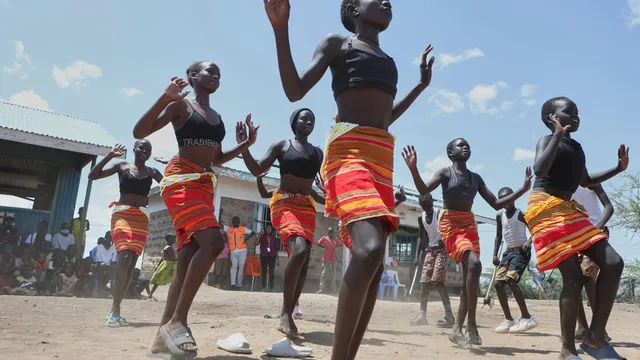
Funding cuts threaten refugee children's survival and cultural expression in Kenya
2025-06-27 04:19- Refugees in Kakuma, Kenya, experience severe funding cuts leading to drastic reductions in food rations.
- Children in the camp engage in dance as both a cultural expression and a coping mechanism against their harsh living conditions.
- The future of cultural programs is under threat due to reduced funding, which may lead to increased vulnerability among refugee children.
Express your sentiment!
Insights
In Kenya's Kakuma camp, more than 300,000 refugees face dire conditions due to severe funding cuts that have halved their monthly food rations. This camp, established in 1992 to provide refuge for individuals fleeing conflicts across East Africa, has seen an increase in challenges as humanitarian support dwindles. Refugee children, who often skip meals to make what little they have last longer, have turned to dance as a means of coping with their harsh reality. The Acholi traditional dance serves not only as a cultural connection for many but also as an emotional outlet, helping them remain resilient in the face of extreme adversity. Among these children is Gladis Amwony, a 20-year-old who has lived in Kakuma for eight years. Having lost any recollection of her home in Uganda, Amwony finds solace in dance that connects her to her heritage. As she participates in these activities, the reduced food provisions have made daily survival a significant concern. Children reportedly receive only 30% of the U.N. nutritional recommendations, making their struggles more pronounced. While some children are focusing on traditional forms of expression, others are embracing modernity, illustrated by a group of boys performing synchronized robotic-style dances. These performances are meant to showcase the rich talent and resilience within the refugee community. However, funding cuts lead to fewer resources and inadequate staffing in children's programs that typically spin off valuable opportunities, including skill development. With only a small number of staff attempting to supervise an overwhelming number of children, there are worries that these essential programs may cease to function in the near future. The situation highlights the importance of cultural programs to keep children engaged and away from negative influences such as child labor and crime. Children's access to creative outlets like dance is critical to their well-being, serving to divert them from the pressures of their environment. However, with donations dwindling and U.S. funding cut back, the sustainability of these activities is uncertain if the status quo continues.
Contexts
The ongoing funding cuts impacting refugees in Kenya pose significant challenges for both the displaced individuals and the host communities. Kenya has been a refuge for thousands of refugees, particularly from neighboring countries like Somalia, South Sudan, and Ethiopia, providing them with essential services such as food, healthcare, and education. However, the reduction in financial support from international organizations and donor countries has led to severe limitations in these services. As a result, refugees are now facing increased food insecurity, inadequate healthcare access, and minimal educational opportunities, which are vital for their integration and future prospects. The humanitarian response has seen a drastic shrinkage in resource allocation, which has exacerbated existing vulnerabilities within refugee camps, including Dadaab and Kakuma. With cuts to funding, there has been a notable decline in nutritional support, leading to malnutrition levels rising among children and pregnant women. Additionally, health services, which were once comprehensive, are struggling to operate, with clinics facing closures and essential medications becoming scarce. This has paved the way for a potential public health crisis, further complicating the already precarious conditions faced by these displaced populations. Moreover, the funding cuts not only affect refugees but also reverberate throughout the local communities surrounding the camps. Local economies often rely on the presence of refugees for labor and business opportunities. As refugee support wanes, there is a tangible impact on local markets, which can lead to economic declines in host communities. This creates an environment of tension and potential conflict between refugees and local residents, as both groups compete for dwindling resources and opportunities. Without sufficient international aid, the delicate balance that currently exists may become unsustainable, leading to increased instability in the region. In response to the challenges posed by these funding cuts, it is imperative for policymakers and humanitarian organizations to advocate for increased support and rethink funding strategies for refugee assistance. This may include fostering partnerships with local organizations, enhancing community-based programs, and leveraging innovative funding mechanisms such as social impact bonds. A scalable response that incorporates the needs of both refugees and host communities is essential to ensure long-term stability and resilience. Collaborative approaches can mitigate the adverse effects of funding cuts and promote a more sustainable future for all stakeholders involved.